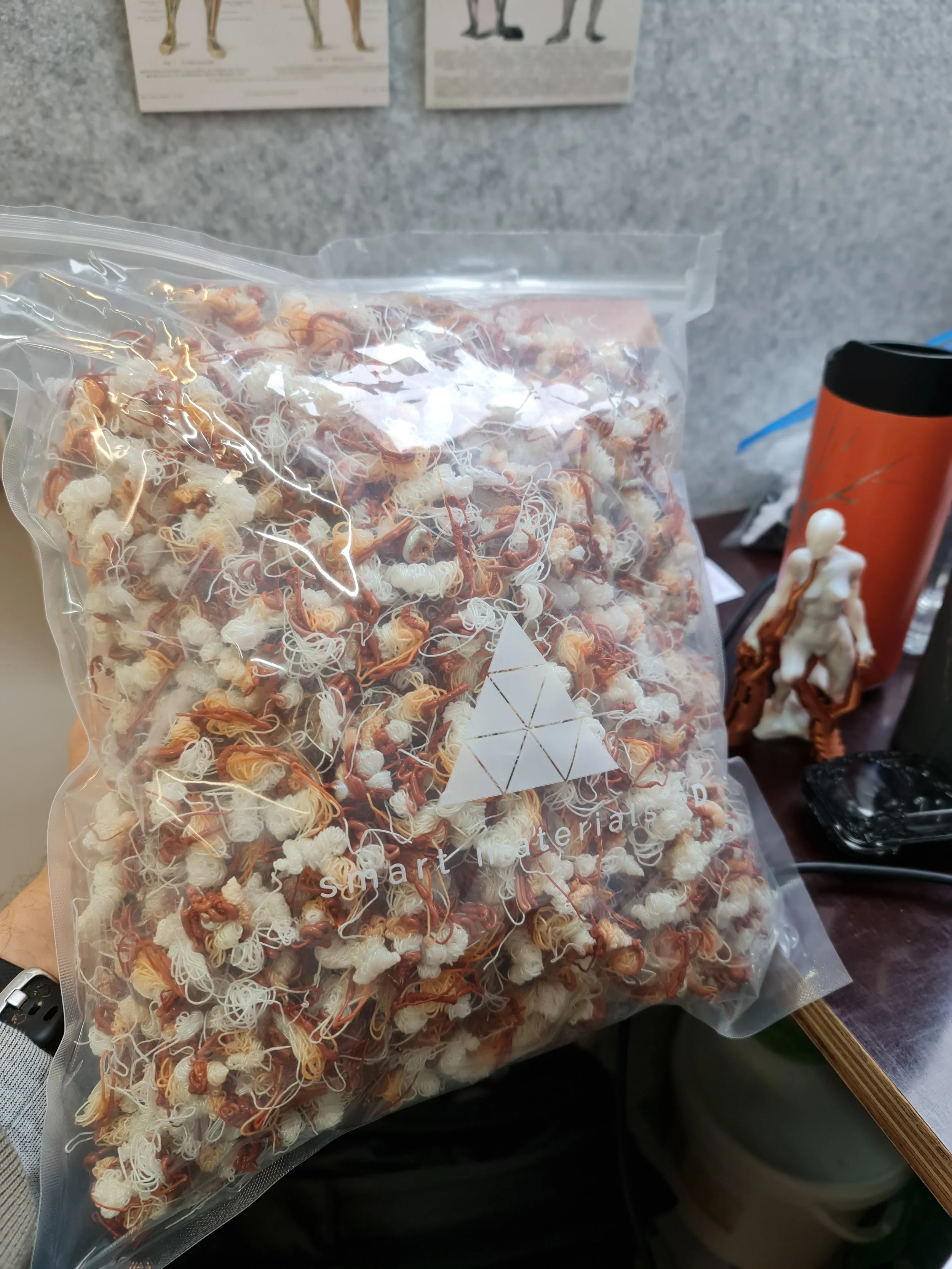Spectre in the Machine
My recent experiments with artificial intelligence and 3D printing have raised some compelling questions about the nature of creativity. This sculpture, Spectre in the Machine, is a direct result of these explorations and an attempt to give physical form to the abstract relationship between a digital consciousness and a physical body.
The title is a direct fusion of two key influences. It takes its conceptual structure from Gilbert Ryle's philosophical idea of the "ghost in the machine," and its spirit and aesthetic from the landmark cyberpunk work, "Ghost in the Shell." Ryle's concept critiques the idea of a separate mind inhabiting a body, arguing they are inseparable. "Ghost in the Shell" takes this question into a future of artificial bodies and challenges where the 'self' truly resides. This sculpture engages with both: it uses the physical dependency described by Ryle to explore the haunting questions of identity posed by "Ghost in the Shell."
I chose the word 'Spectre' specifically because the AI's creation doesn't feel like a true 'ghost' or soul; it's something more hollow and unsettling—a statistical echo of humanity. It’s a spectre haunting the machine, not a soul inhabiting it.
The Digital Spectre
The process began with an AI. As with some of my previous work, I prompted it to generate a 3D model of a person without any visual reference. The resulting form was unsettling—an almost-human shape that I saw not as a mind or a "ghost," but as a hollow spectre, an incomplete echo of human creativity.
To translate this idea physically, I chose materials carefully. The figure is rendered in an ethereal, silk white filament, giving it a luminous, spectral quality. However, its internal structure, revealed by the visible copper infill and its reliance on external supports, deliberately exposes that it is not a solid, self-contained being. This shows the underlying composition of the spectre, a form reliant on its internal "machine."
The Physical Machine
The choice of materials is integral to this idea. While the figure itself is a spectral white, the supports and internal infill are printed in a stark copper filament. This copper represents the raw, mechanical essence—the "machine" that gives the spectre its structure. This also gives the title a second, more literal meaning: during its long hours of creation, the 14cm piece existed as a ghostly form slowly materializing inside the physical machine of the 3D printer.
The AI-generated form is inherently unbalanced; it cannot support itself. This dependency is central to the work's meaning. The digital "spectre," for all its aesthetic complexity, is utterly reliant on its physical "machine" to exist. The copper supports are not merely functional; they are a visible metaphor for the indispensable role of the machine in granting the digital concept a tangible presence.
The Core Inquiry
Ultimately, this sculpture uses the tangible, often flawed, process of 3D printing to grapple with the nature of these new, disembodied spectres we are creating.
This sculpture poses a question: Is AI a true creator, or is it a sophisticated mirror, a spectral echo of our collective data, made physical only through the grace of a machine? It's an inquiry into the nature of its existence, and our own, as the lines between digital and physical continue to blur.
The Material Cost of a Spectre
The journey of a digital concept into a physical object is written in a language of tangible costs. While the AI's creation may seem ethereal, its manifestation is bound by the strict laws of matter, energy, and time. The "machine" in this process is not only the 3D printer but also the vast, often invisible, infrastructure of computation that breathes life into the "spectre" in the first place.
The statistics from this single print job reveal a profound inefficiency, a physical echo of the trial-and-error nature of both machine learning and 3D fabrication.
Print Specifications
Total Print Time: 2 days, 5 hours, 39 minutes
Filament Changes: 1,282
Print Head Travel: 4,314.15 meters
The machine’s exhaustive path, a frantic and intricate dance of over 4.3 kilometers, is visualized below. This digital blueprint of movement was required to deposit just a few grams of material with precision.
Material Consumption
Total Filament Used: 839.84g
White: 549.44g
Copper: 290.40g
Filament in Final Model: 26.79g
White (body): 17.06g
Copper (infill & supports): 9.73g
Total Purged Waste: 813.05g (96.8% of total material)
Each of the 1,282 filament changes contributed to a physical record of this inefficiency. It is important to note that while different print settings could have drastically reduced this waste, the extreme material cost was embraced as a conceptual element of the work. The sheer volume of purged plastic is allowed to become part of the narrative, serving as a stark visualization of a cost which is often hidden, especially in digital services like AI.
This tangible waste—over 96% of the total material—acts as a physical anchor for a much larger, less visible ledger of consumption. The AI model itself is a product of immense computational power, vast data centers, and the significant electrical thirst of the servers that train and run it. The clean, minimalist output of an AI prompt belies a "waste product" of heat, carbon emissions, and resource allocation on a global scale.
In this light, the machine is not just the printer in the studio but the entire network of servers and power grids. The true cost of the spectre is therefore twofold: the visible, material sacrifice of the printing process and the invisible, energetic footprint of the artificial mind that conceived it. The sculpture, in its final, delicate form, is a ghost born from two machines—one of plastic and motion, the other of silicon and electricity.


